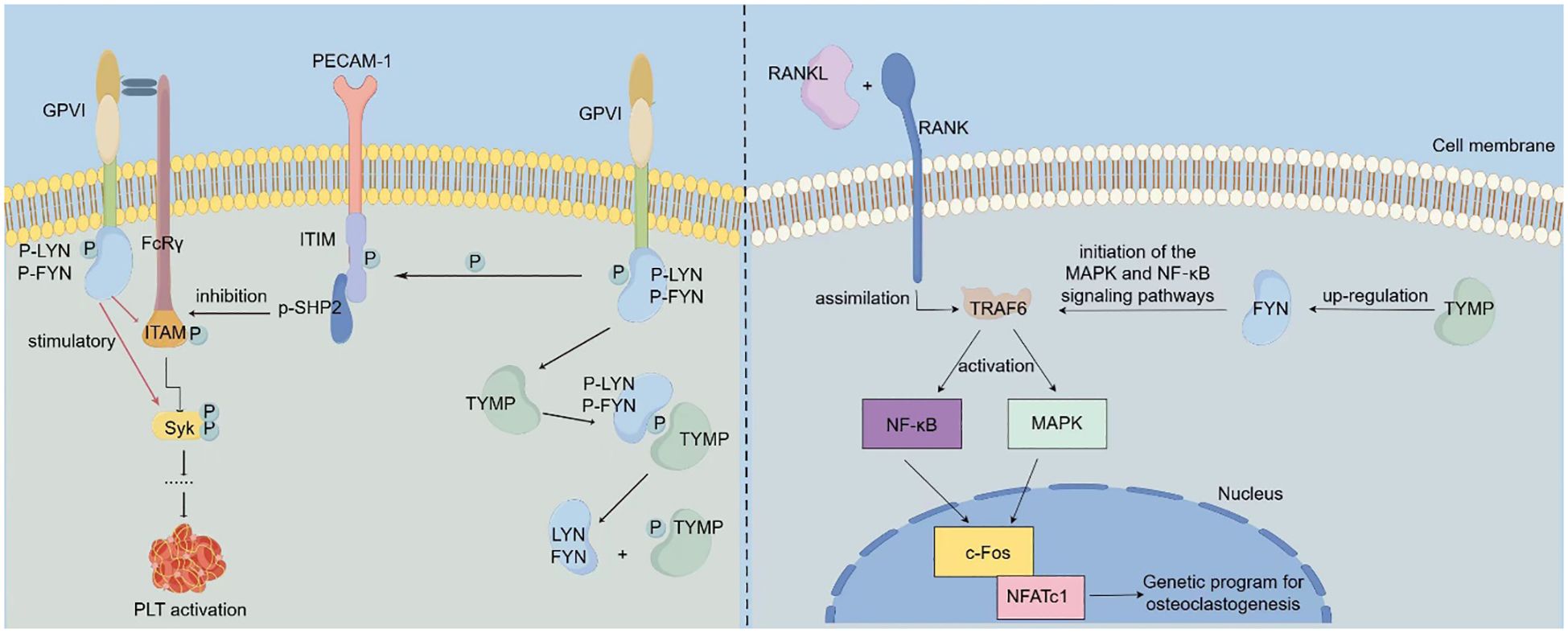- 1Liaoning Cancer Hospital & Institute, Shenyang, China
- 2First Affiliated Hospital of Dalian Medical University, Dalian, China
A Correction on
Thymidine phosphorylase in nucleotide metabolism: physiological functions and its implications in tumorigenesis and anti-cancer therapy
By Huang B, Yuan Q, Sun J, Wang C and Yang D (2025). Front. Immunol. 16:1561560. doi: 10.3389/fimmu.2025.1561560
In the published article, there was an error in the legend for Figure 1 Mechanisms via which TYMP promotes platelet activation and osteoclast differentiation. as published. The left-hand part of Figure 1, illustrating the mechanism by which TYMP regulates platelet activation, was adapted from Figure 7 of the paper by Li et al. (2014), titled “Thymidine Phosphorylase Participates in Platelet Signaling and Promotes Thrombosis” (https://doi.org/10.1161/CIRCRESAHA.115.304591). However, we did not indicate this in the figure legend. The corrected legend appears below.

Figure 1. Mechanisms via which TYMP promotes platelet activation and osteoclast differentiation (The left-hand panel was adapted from Li et al. (2014) (12)). LYN and FYN bind to the cytoplasmic domain of one GPVI molecule, while the other GPVI molecule interacts with the FcRγ chain dimer, thereby initiating the GPVI signaling pathway. Activation of this pathway results in LYN and FYN stimulating the phosphorylation of ITAM and Syk, which in turn activates platelet activation. Concurrently, LYN inhibits collagen-induced platelet activation by promoting the phosphorylation of the immunoreceptor tyrosine inhibitory motif (ITIM) domain of platelet endothelial cell adhesion molecule 1 (PECAM1). TYMP binds to the phosphate group of p-LYN, dephosphorylating it and causing the loss of its ability to mediate PECAM-1/ITIM phosphorylation. This action attenuates LYN’s inhibitory function on collagen-induced platelet activation, thereby indirectly promoting platelet activation and contributing to thrombosis. In OC precursor cells, RANKL binds to the RANK receptor on OC precursors, leading to the recruitment of TRAF6, which activates NF-kB and AP-1 transcription factors, triggering downstream signaling pathways. This activation promotes the expression of c-Fos and NFATc1, key drivers of osteoclast differentiation. In TYMP-stimulated cells, the expression of FYN is significantly increased. TYMP activates FYN signaling, which subsequently promotes the activation of MAPK and NF-kB signaling pathways, thereby facilitating osteoclast differentiation.
The original version of this article has been updated.
Publisher’s note
All claims expressed in this article are solely those of the authors and do not necessarily represent those of their affiliated organizations, or those of the publisher, the editors and the reviewers. Any product that may be evaluated in this article, or claim that may be made by its manufacturer, is not guaranteed or endorsed by the publisher.
Keywords: nucleotide metabolism, thymidine phosphorylase, physiological functions, tumorigenesis, anticancer therapy
Citation: Huang B, Yuan Q, Sun J, Wang C and Yang D (2025) Correction: Thymidine phosphorylase in nucleotide metabolism: physiological functions and its implications in tumorigenesis and anti-cancer therapy. Front. Immunol. 16:1642752. doi: 10.3389/fimmu.2025.1642752
Received: 07 June 2025; Accepted: 24 June 2025;
Published: 09 July 2025.
Edited and reviewed by:
Renjun Gu, Nanjing University of Chinese Medicine, Nanjing, ChinaCopyright © 2025 Huang, Yuan, Sun, Wang and Yang. This is an open-access article distributed under the terms of the Creative Commons Attribution License (CC BY). The use, distribution or reproduction in other forums is permitted, provided the original author(s) and the copyright owner(s) are credited and that the original publication in this journal is cited, in accordance with accepted academic practice. No use, distribution or reproduction is permitted which does not comply with these terms.
*Correspondence: Dong Yang, eWFuZ2Rvbmd5aTIwMTBAMTI2LmNvbQ==
†These authors have contributed equally to this work
 Bo Huang1,2†
Bo Huang1,2† Qihang Yuan
Qihang Yuan Jiaao Sun
Jiaao Sun Chao Wang
Chao Wang Dong Yang
Dong Yang